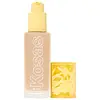Kylie Cosmetics Skin Tint Blurring Elixir Foundation Versus Kosas Revealer Skin-Improving Foundation SPF 25
What's inside
What's inside
 Key Ingredients
Key Ingredients

 Benefits
Benefits

 Concerns
Concerns

 Ingredients Side-by-side
Ingredients Side-by-side

Water
Skin ConditioningIsododecane
EmollientDimethicone
EmollientTrimethylsiloxysilicate
EmollientPropanediol
SolventCetyl PEG/PPG-10/1 Dimethicone
EmulsifyingPentylene Glycol
Skin ConditioningPhenyl Trimethicone
Skin ConditioningSilica
AbrasiveSodium Chloride
MaskingDisteardimonium Hectorite
StabilisingDimethicone Crosspolymer
Emulsion StabilisingMagnesium Sulfate
Sodium Dehydroacetate
PreservativePotassium Sorbate
PreservativeEthylene Brassylate
MaskingPropylene Carbonate
SolventMica
Cosmetic ColorantC24-28 Alkyl Methicone
EmollientTriethoxycaprylylsilane
Sodium Hyaluronate
HumectantAluminum Hydroxide
EmollientPentaerythrityl Tetra-Di-T-Butyl Hydroxyhydrocinnamate
AntioxidantCI 77891
Cosmetic ColorantCI 77491
Cosmetic ColorantCI 77492
Cosmetic ColorantCI 77499
Cosmetic ColorantCI 77163
Cosmetic ColorantWater, Isododecane, Dimethicone, Trimethylsiloxysilicate, Propanediol, Cetyl PEG/PPG-10/1 Dimethicone, Pentylene Glycol, Phenyl Trimethicone, Silica, Sodium Chloride, Disteardimonium Hectorite, Dimethicone Crosspolymer, Magnesium Sulfate, Sodium Dehydroacetate, Potassium Sorbate, Ethylene Brassylate, Propylene Carbonate, Mica, C24-28 Alkyl Methicone, Triethoxycaprylylsilane, Sodium Hyaluronate, Aluminum Hydroxide, Pentaerythrityl Tetra-Di-T-Butyl Hydroxyhydrocinnamate, CI 77891, CI 77491, CI 77492, CI 77499, CI 77163
Zinc Oxide 7.5%
Cosmetic ColorantWater
Skin ConditioningEthylhexyl Olivate
Skin ConditioningOctyldodecanol
EmollientUndecane
EmollientPolyglyceryl-2 Dipolyhydroxystearate
Skin ConditioningGlycerin
HumectantMica
Cosmetic ColorantCalcium Sodium Borosilicate
Caprylic/Capric Triglyceride
MaskingNiacinamide
SmoothingPolyglyceryl-3 Diisostearate
EmulsifyingGalactoarabinan
Tridecane
PerfumingPropanediol
SolventCetyl Alcohol
EmollientGlyceryl Oleate
EmollientSodium Hyaluronate
HumectantPalmitoyl Tripeptide-5
Skin ConditioningPanthenol
Skin ConditioningSqualane
EmollientCaffeine
Skin ConditioningArnica Montana Flower Extract
MaskingArtemisia Capillaris Flower Extract
Skin ConditioningEthyl Ferulate
AntioxidantSodium Gluconate
Skin ConditioningPolyhydroxystearic Acid
EmulsifyingMaltodextrin
AbsorbentPentylene Glycol
Skin ConditioningLecithin
EmollientHydrogenated Lecithin
EmulsifyingTocopherol
AntioxidantPhenethyl Alcohol
MaskingCI 77891
Cosmetic ColorantIron Oxides
Zinc Oxide 7.5%, Water, Ethylhexyl Olivate, Octyldodecanol, Undecane, Polyglyceryl-2 Dipolyhydroxystearate, Glycerin, Mica, Calcium Sodium Borosilicate, Caprylic/Capric Triglyceride, Niacinamide, Polyglyceryl-3 Diisostearate, Galactoarabinan, Tridecane, Propanediol, Cetyl Alcohol, Glyceryl Oleate, Sodium Hyaluronate, Palmitoyl Tripeptide-5, Panthenol, Squalane, Caffeine, Arnica Montana Flower Extract, Artemisia Capillaris Flower Extract, Ethyl Ferulate, Sodium Gluconate, Polyhydroxystearic Acid, Maltodextrin, Pentylene Glycol, Lecithin, Hydrogenated Lecithin, Tocopherol, Phenethyl Alcohol, CI 77891, Iron Oxides
 Reviews
Reviews

Ingredients Explained
These ingredients are found in both products.
Ingredients higher up in an ingredient list are typically present in a larger amount.
Ci 77891 is a white pigment from Titanium dioxide. It is naturally found in minerals such as rutile and ilmenite.
It's main function is to add a white color to cosmetics. It can also be mixed with other colors to create different shades.
Ci 77891 is commonly found in sunscreens due to its ability to block UV rays.
Learn more about CI 77891Mica is a naturally occurring mineral used to add shimmer and color in cosmetics. It can also help improve the texture of a product or give it an opaque, white/silver color.
Serecite is the name for very fine but ragged grains of mica.
This ingredient is often coated with metal oxides like titanium dioxide. Trace amounts of heavy metals may be found in mica, but these metals are not harmful in our personal products.
Mica has been used since prehistoric times throughout the world. Ancient Egyptian, Indian, Greek, Roman, Aztec, and Chinese civilizations have used mica.
Learn more about MicaPentylene glycol is typically used within a product to thicken it. It also adds a smooth, soft, and moisturizing feel to the product. It is naturally found in plants such as sugar beets.
The hydrophilic trait of Pentylene Glycol makes it a humectant. As a humectant, Pentylene Glycol helps draw moisture from the air to your skin. This can help keep your skin hydrated.
This property also makes Pentylene Glycol a great texture enhancer. It can also help thicken or stabilize a product.
Pentylene Glycol also acts as a mild preservative and helps to keep a product microbe-free.
Some people may experience mild eye and skin irritation from Pentylene Glycol. We always recommend speaking with a professional about using this ingredient in your routine.
Pentylene Glycol has a low molecular weight and is part of the 1,2-glycol family.
Learn more about Pentylene GlycolPropanediol is an all-star ingredient. It softens, hydrates, and smooths the skin.
It’s often used to:
Propanediol is not likely to cause sensitivity and considered safe to use. It is derived from corn or petroleum with a clear color and no scent.
Learn more about PropanediolSodium Hyaluronate is hyaluronic acid's salt form. It is commonly derived from the sodium salt of hyaluronic acid.
Like hyaluronic acid, it is great at holding water and acts as a humectant. This makes it a great skin hydrating ingredient.
Sodium Hyaluronate is naturally occurring in our bodies and is mostly found in eye fluid and joints.
These are some other common types of Hyaluronic Acid:
Learn more about Sodium HyaluronateWater. It's the most common cosmetic ingredient of all. You'll usually see it at the top of ingredient lists, meaning that it makes up the largest part of the product.
So why is it so popular? Water most often acts as a solvent - this means that it helps dissolve other ingredients into the formulation.
You'll also recognize water as that liquid we all need to stay alive. If you see this, drink a glass of water. Stay hydrated!
Learn more about Water